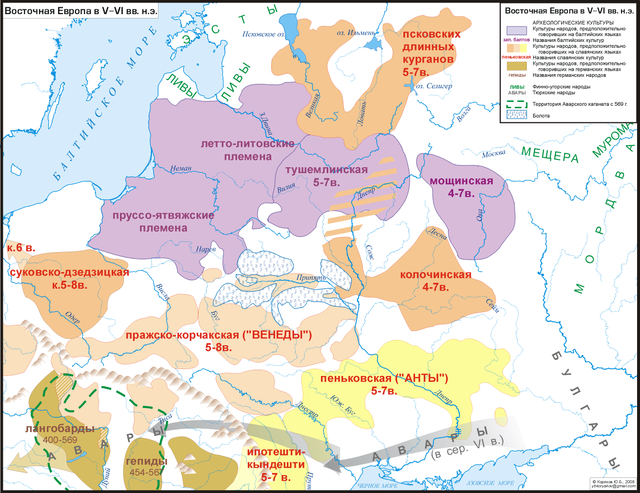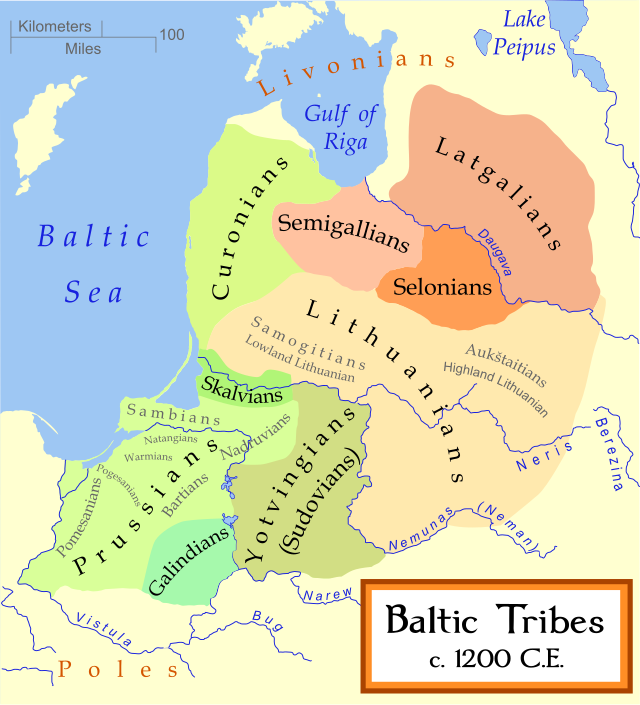List of ancient Baltic peoples and tribes
From Wikipedia, the free encyclopedia
The following is a list of ancient Baltic peoples and tribes.
Background
This is a list of the ancient Baltic peoples and tribes. They spoke the Baltic languages (members of the broader Balto-Slavic), a branch of the Indo-European language family, which was originally spoken by tribes living in area east of Jutland peninsula, southern Baltic Sea coast in the west and Moscow, Oka and Volga rivers basins in the east, to the northwest of the Eurasian steppe. Modern descendants are the Lithuanians and Latvians (they themselves assimilated other related Baltic tribes).
List of ancient Baltic peoples and tribes (table)
Summarize
Perspective
†Extinct
Ancestors

- Proto-Indo-Europeans (Proto-Indo-European speakers)
- Proto-Balto-Slavs (common ancestors of Balts and Slavs) (Proto-Balto-Slavic speakers)
- Proto-Balts (Proto-Baltic speakers)
- Proto-Balto-Slavs (common ancestors of Balts and Slavs) (Proto-Balto-Slavic speakers)
List of Ancient Baltic peoples and tribes (kinship tree)


Plain-Pottery culture, AKA Dnepr-Dvina culture
Bell-shaped burials group




- Balts
- Eastern Balts
- Eastern Galindians
- Eastern (Middle) Balts
- Latgalians (Latgaļi / Letgaļi / Leti) (they lived in Latgalia — Latgola)
- Latvians (they were formed by the merger of Latgalians, as the main component, with the Selonians, Semigallians, Curonians and Livonians, the last ones are a Finnic people and not an Indo-European one) (they live in Latvia)
- Transitional Balts (between Latgalians and Lithuanians)
- Selonians (they lived in Selonia — Sēlija)
- Semigallians (they lived in Semigallia — Zemgale)
- Curonians (they lived in Curonia or Courland)
- Curonian Kings (Kuršu Koniņi) (a distinct Latvian cultural group of Curonian ancestry) (they live in seven villages between Kuldīga and Aizpute in Courland)
- Kursenieki (although they adopted a Latvian dialect, with Curonian substrate, they keep a distinct Curonian ethnic identity and name) (they lived in the Curonian and Vistula Spits)
- Lithuanians (Senlietuviai) (they lived in Eastern Lithuania, later expanding westward into Samogitian territory and forming a separate cultural group — the Aukštaitians)
- Samogitians (Žemaitē) (they lived in Samogitia, might have been a distinct Baltic tribe)
- Prussian Lithuanians or Small Lithuanians (Lietuvininkai) (they lived in Lithuania Minor, northeastern Prussia)
- Latgalians (Latgaļi / Letgaļi / Leti) (they lived in Latgalia — Latgola)
- Western Balts
- Scalovians (Skallawai) (they lived in Scalovia — Skallawa)
- Prussians (Old Prussians, Baltic Prussians) (Prūsai) (they lived in Prussia, Old Prussia or Baltic Prussia)
- Bartians (Bartai) (they lived in Bartia — Barta)
- Lubavians (Lubawai) (they lived in Lubavia — Lūbawa)
- Nadruvians (Nadrāuwai) (they lived in Nadruvia — Nadrāuwa)
- Natangians (Natangai or Notangiai) (they lived in Natangia — Nātanga or Notangi)
- Pogesanians (Paguddiai) (they lived in Pogesania — Paguddi)
- Pomesanians (Pameddiai) (they lived in Pomesania — Pameddi)
- Sambians (Sembai) (they lived in Sambia — Semba)
- Sasnans (Sasnai) (they lived in Sasna)
- Warmians (Wārmiai) (they lived in Warmia — Wārmi)
- Western Galindians (Galindai) (they lived in Western Galindia — Galinda)
- Yotvingians (they lived in Yotvingia)
- Eastern Balts
Hypothetical Ancient Baltic peoples and tribes
- Eastern Balts
- Dniepr-Oka Balts
- Dniepr Balts
- Oka Balts
- Dniepr-Oka Balts
- Western Balts
Possible Balts
Balts or Slavs
Balts, Slavs or Uralics
Notes
External links
Wikiwand - on
Seamless Wikipedia browsing. On steroids.